CITIZEN PPU-700II User Manual
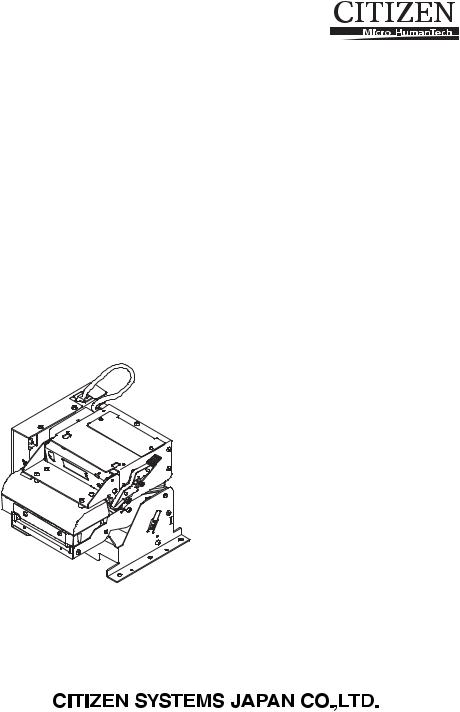
PRINTER PRESENTER UNIT
MODEL PPU-700/700II
User’s Manual
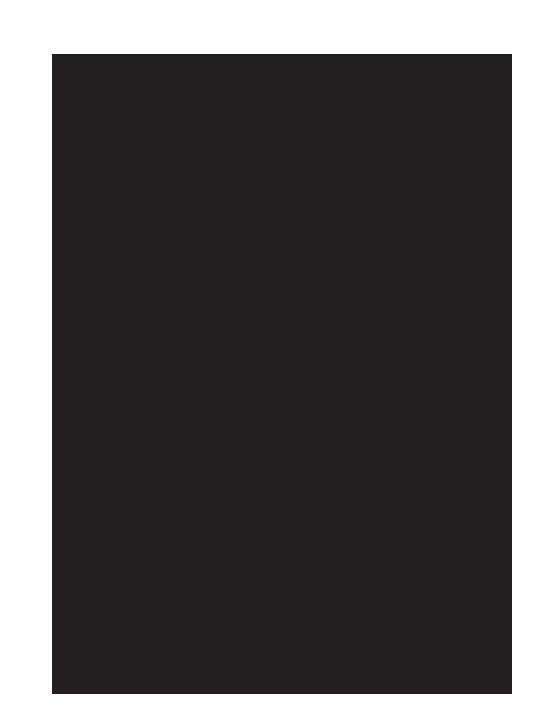
WEEE MARK
En ,I \RX ZDQW WR GLVSRVH WKLV SURGXFW GR QRW PL[ ZLWK JHQHUDO KRXVHKROG ZDVWH 7KHUH LV D VHSDUDWH FROOHFWLRQ V\VWHPV IRU XVHG HOHFWURQLFV SURGXFWV LQ DFFRUGDQFH ZLWK OHJLVODWLRQ XQGHU WKH :((( 'LUHFWLYH 'LUHFWLYH (& DQG LV HIIHFWLYH RQO\ ZLWKLQ (XURSHDQ 8QLRQ
Ge :HQQ 6LH GLHVHV 3URGXNW HQWVRUJHQ ZROOHQ GDQQ WXQ 6LH GLHV ELWWH QLFKW ]XVDPPHQ PLW GHP
+DXVKDOWVP OO (V JLEW LP 5DKPHQ GHU :((( 'LUHNWLYH LQQHUKDOE GHU (XURSlLVFKHQ 8QLRQ
'LUHNWLYH (& JHVHW]OLFKH %HVWLPPXQJHQ I U VHSDUDWH 6DPPHOV\VWHPH I U JHEUDXFKWH
HOHNWURQLVFKH *HUlWH XQG 3URGXNWH
Fr 6L YRXV VRXKDLWH] YRXV GpEDUUDVVHU GH FHW DSSDUHLO QH OH PHWWH] SDV j OD SRXEHOOH DYHF YRV RUGXUHV PpQDJqUHV ,O H[LVWH XQ V\VWqPH GH UpFXSpUDWLRQ GLVWLQFW SRXU OHV YLHX[ DSSDUHLOV pOHFWURQLTXHV FRQIRUPpPHQW j OD OpJLVODWLRQ :((( VXU OH UHF\FODJH GHV GpFKHWV GHV pTXLSHPHQWV pOHFWULTXHV HW pOHFWURQLTXHV 'LUHFWLYH (& TXL HVW XQLTXHPHQW YDODEOH GDQV OHV SD\V GH O¶8QLRQ HXURSpHQQH /HV DSSDUHLOV HW OHV PDFKLQHV pOHFWULTXHV HW pOHFWURQLTXHV FRQWLHQQHQW VRXYHQW GHV PDWLqUHV GDQJHUHXVHV SRXU O¶KRPPH HW O¶HQYLURQQHPHQW VL YRXV OHV XWLOLVH] HW YRXV YRXV HQ GpEDUUDVVH] GH IDoRQ LQDSSURSULpH
Sp 6L GHVHD GHVKDFHUVH GH HVWH SURGXFWR QR OR PH]FOH FRQ UHVLGXRV GRPpVWLFRV GH FDUiFWHU
JHQHUDO ([LVWH XQ VLVWHPD GH UHFRJLGD VHOHFWLYD GH DSDUDWRV HOHFWUyQLFRV XVDGRV VHJ~Q
HVWDEOHFH OD OHJLVODFLyQ SUHYLVWD SRU OD 'LUHFWLYD &( VREUH UHVLGXRV GH DSDUDWRV
HOpFWULFRV \ HOHFWUyQLFRV 5$(( YLJHQWH ~QLFDPHQWH HQ OD 8QLyQ (XURSHD
It 6H GHVLGHUDWH JHWWDUH YLD TXHVWR SURGRWWR QRQ PHVFRODWHOR DL ULILXWL JHQHULFL GL FDVD (VLVWH
XQ VLVWHPD GL UDFFROWD VHSDUDWR SHU L SURGRWWL HOHWWURQLFL XVDWL LQ FRQIRUPLWj DOOD OHJLVOD]LRQH
5$(( 'LUHWWLYD &( YDOLGD VROR DOO¶LQWHUQR GHOO¶8QLRQH (XURSHD
Du 'HSRQHHU GLW SURGXFW QLHW ELM KHW JHZRQH KXLVKRXGHOLMN DIYDO ZDQQHHU X KHW ZLOW YHUZLMGHUHQ (U EHVWDDW LQJHYROJH GH :((( ULFKWOLMQ 5LFKWOLMQ (* HHQ VSHFLDDO ZHWWHOLMN YRRUJHVFKUHYHQ YHU]DPHOV\VWHHP YRRU JHEUXLNWH HOHNWURQLVFKH SURGXFWHQ ZHON DOOHHQ JHOGW ELQQHQ GH (XURSHVH 8QLH
Da +YLV GX YLO VNLOOH GLJ DI PHG GHWWH SURGXNW Pn GX LNNH VPLGH GHW XG VDPPHQ PHG GLW DOPLQGHOLJH KXVKROGQLQJVDIIDOG 'HU ILQGHV HW VHSDUDW LQGVDPOLQJVV\VWHP IRU XGWMHQWH HOHNWURQLVNH SURGXNWHU L RYHUHQVVWHPPHOVH PHG ORYJLYQLQJHQ XQGHU :((( GLUHNWLYHW GLUHNWLY (& VRP NXQ HU J OGHQGH L GHQ (XURS LVNH 8QLRQ
Por 6H TXLVHU GHLWDU IRUD HVWH SURGXWR QmR R PLVWXUH FRP R OL[R FRPXP 'H DFRUGR FRP D OHJLVODomR TXH GHFRUUH GD 'LUHFWLYD 5((( ± 5HVtGXRV GH (TXLSDPHQWRV (OpFWULFRV H (OHFWUyQLFRV&( H[LVWH XP VLVWHPD GH UHFROKD VHSDUDGR SDUD RV HTXLSDPHQWRV HOHFWUyQLFRV IRUD GH XVR HP YLJRU DSHQDV QD 8QLmR (XURSHLD
Pol -HĪHOL ]DPLHU]DV] SR]E\ü VLĊ WHJR SURGXNWX QLH Z\U]XFDM JR UD]HP ]H ]Z\Ná\PL
GRPRZ\PL RGSDGNDPL :HGáXJ G\UHNW\Z\ :((( '\UHNW\ZD (&
RERZLą]XMąFHM Z 8QLL (XURSHMVNLHM GOD XĪ\ZDQ\FK SURGXNWyZ HOHNWURQLF]Q\FK
QDOHĪ\ VWRVRZDü RGG]LHOQH VSRVRE\ XW\OL]DFML
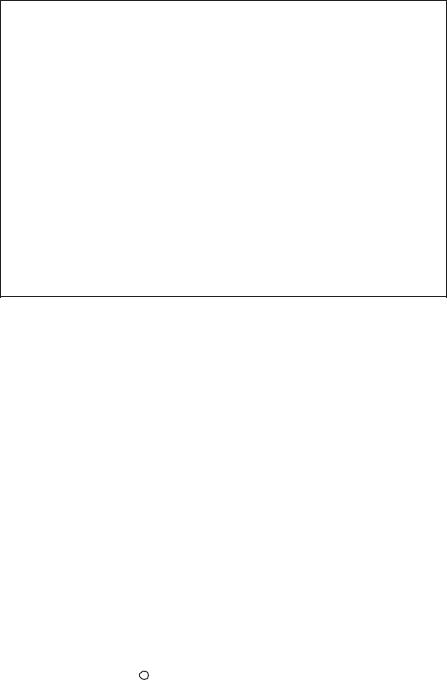
Declaration of Conformity
This printer conforms to the following Standards:
The Low Voltage Directive 2006/95/EC, the EMC Directive 2004/108/EC, the RoHS Directive 2002/95/EC, and the WEEE Directive 2002/96/EC.
LVD : EN60950-1 |
|
EMC : EN55022 |
Class A |
EN61000-3-2
EN61000-3-3
EN55024
This declaration applies only to the 230-V model.
CITIZEN is a registered trade mark of Citizen Holdings Co., Japan CITIZEN es una marca registrada de Citizen Holdings Co., Japón
Company names and product names in this manual are trademarks or registered trademarks of relevant companies.
Copyright c 2010 by CITIZEN SYSTEMS JAPAN CO., LTD.

IMPORTANT: This equipment generates, uses, and can radiate radio frequency energy and if not installed and used in accordance with the instruction manual, may cause interference to radio communications. It has been tested and found to comply with the limits for a Class A computing device pursuant to Subpart J of Part 15 of FCC Rules, which are designed to provide reasonable protection against such interference when operated in a commercial environment. Operation of this equipment in a residential area is likely to cause interference, in which case the user at his own expense will be required to take whatever measures may be necessary to correct the interference.
CAUTION: Use shielded cable for this equipment.
Sicherheitshinweis
Die Steckdose zum Anschluß dieses Druckers muß nahe dem Gerät angebracht und leicht zugänglich sein.
For Uses in Canada
This digital apparatus does not exceed the class A limits for radio noise emissions from digital apparatus, as set out in the radio interference regulations of the Canadian department of communications.
Pour L’utilisateurs Canadiens
Cet appareil numérique ne dépasse pas les limites de carégorie a pour les émissions de bruit radio émanant d’appareils numériques, tel que prévu dans les réglements sur l’interférence radio du départment Canadien des communications.
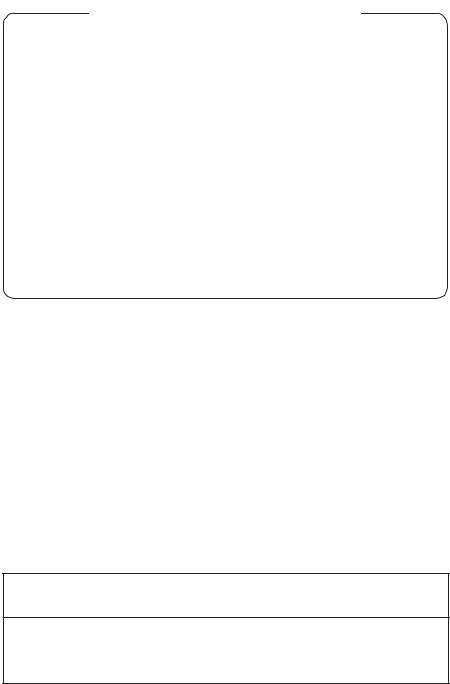
GENERAL PRECAUTIONS
1.The information contained in this manual is subject to change without prior notice.
2.Reproduction or transfer of part or all of this manual in any means is prohibited without permission from CITIZEN SYSTEMS.
3.Except explained elsewhere in this manual, do not attempt to service, disassemble, or repair this product.
4.Note that CITIZEN SYSTEMS is not responsible for any damage attributable to incorrect operation/handling or improper operating environments that are not specified in this manual.
5.Operate this printer only as described in this manual. Failure to do so may cause accidents or other problems.
6.Data are basically for temporary use and not for storage for a long period or permanently. Please note that CITIZEN SYSTEMS is not responsible for damage or lost profit resulting from the loss of data caused by accidents, repairs, tests or other occurrence.
7.If you find loss of information, error, or uncertain matter, please contact your CITIZEN SYSTEMS dealer.
8.Please note CITIZEN SYSTEMS is not responsible for anything that may occur from operating this printer regardless of what is stated in “7” above.
 CAUTION
CAUTION
This is a Class A information technology equipment based on the standard of the Voluntary Control Council for Interference by Information Technology Equipment (VCCI). If this equipment is used in a domestic environment, radio disturbance may arise. When such trouble occurs, the user may be required to take corrective actions.
— 1 —
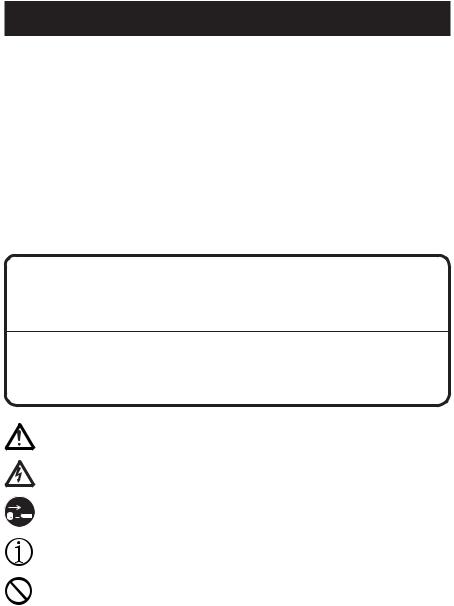
SAFETY PRECAUTIONS ... WHICH SHOULD BE STRICTLY OBSERVED
Before using this product for the first time, carefully read these SAFETY PRECAUTIONS.
Incorrect operation may result in unexpected accidents (fire, electric shock, or injury).
●After having read this manual, keep it in a safe, readily accessible place for future reference.
●Some of the descriptions contained in this manual may not be relevant to some printer models.
In order to prevent injury hazard to operators, third parties or damage to property, special warning symbols are used in this user’s manual to indicate important items to be strictly observed.
The following describes the degree of hazard and damage that could occur if the printer is improperly operated by ignoring the instructions indicated by the warning symbols.
 WARNING
WARNING
Neglecting the precautions indicated by this symbol may result in fatal or serious injury.
 CAUTION
CAUTION
Neglecting the precautions indicated by this symbol may result in injury or damage to properties.
This symbol is used to alert your attention to important items.
This symbol is used to alert you to the danger of electric shock or electrostatic damage.

 This symbol denotes a request to unplug the printer from the wall outlet.
This symbol denotes a request to unplug the printer from the wall outlet.
This symbol is used to indicate the “information” on the use, or the like.
This symbol is used to indicate prohibited actions.
— 2 —
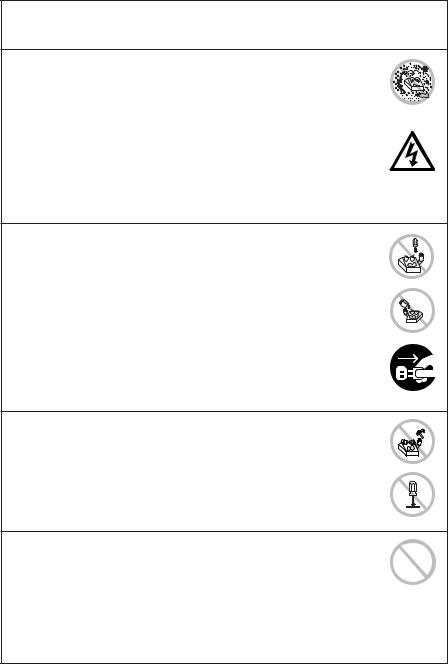
 WARNING
WARNING
Do not use or store this product in a place where it will be exposed to:
●Flames or moist air
●Direct sunlight
●Hot airflow or radiation from a heating device
●Salty air or corrosive gases
●Ill-ventilated atmosphere
●Chemical reactions in a laboratory
●Airborne oil, steel particles, or dust
●Static electricity or strong magnetic field
•Neglecting these warnings may result in printer failure, overheating, emission of smoke, fire, or electric shock.
Do not drop any foreign object nor spill liquid into the printer. Do not place any object on the printer either.
●Do not drop any metallic object such as paper clip, pin or screw into the printer.
●Do not place a flower vase, pot or cup containing water on the printer.
●Do not spill coffee, soft drinks or any other liquid into the printer.
●Do not spray insecticide or any other chemical liquid over the printer.
●Never use organic cleaning solvent such as alcohol, paint thinner,
trichloroethylene, benzene, or ketone.
•A metallic foreign object, if accidentally dropped into the printer, may cause printer failure, fire, or electric shock. Should it occur, immediately turn the printer off, unplug it from the supply outlet, and call your local CITIZEN SYSTEMS dealer.
Do not handle the printer in the following ways:
●Do not allow the printer to sustain strong impacts or hard jolts (e.g., trampling, dropping, striking with a hard edge).
●Never attempt to disassemble or modify the printer.
•Neglecting to handle properly may result in printer failure, overheating, emission of smoke, fire, or electric shock.
Install, use, or store the printer out of the reach of children.
•Electric appliances could cause an unexpected injury or accident if they are handled or used improperly.
•Keep the power cord and signal cables out of the reach of children. Also children should not be allowed to gain access to any internal part of the printer.
•The plastic bag the printer came in must be disposed of properly or kept away from children. Wearing it over the head may lead to suffocation.
—3 —

 WARNING
WARNING
Please observe the following precautions for power source and power cord:
●Do not plug or unplug the power cord with a wet hand.
●Use the printer only at the specified supply voltage and frequency.
●Use only the specified AC adapter with the printer.
●Check to make sure that the supply outlet from which the printer is powered has a sufficient capacity.
●Do not supply the printer from a power strip or current tap shared with other appliances.
●Do not plug the power cord into a supply outlet with dust or debris left on its plug.
●Do not use a deformed or damaged power cord.
•Neglecting to handle properly may result in printer failure, emission of smoke, fire, or electric shock.
•An overload may cause the power cord to overheat or fire or the circuit breaker to trip.
●Do not use the printer while the power cord is loaded with anything or it is trampled on.
●Do not use or carry the printer with its power cord bent, twisted, or pulled.
●Do not attempt to modify the power cord unnecessarily.
●Do not lay the power cord in the neighbor of a heating device.
•Neglecting these cautions may cause wires or insulation to break, which could result in leakage, electric shock, or printer failure. If a power cord sustains damage contact your CITIZEN SYSTEMS dealer.
●Do not leave things around the supply outlet.
●Supply power to the printer form a convenient wall outlet, readily accessible in an emergency.
• The printer may not be immediately shut down in an emergency.
●Insert the power plug fully into the supply outlet.
●If the printer is likely to be out of use for a long time, leave it disconnected from its supply outlet.
— 4 —
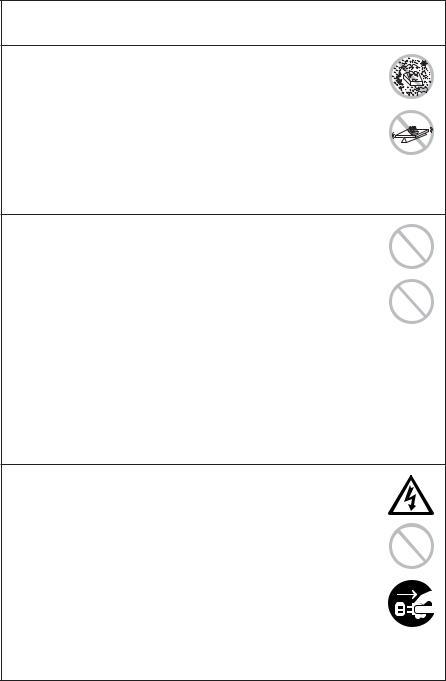
 CAUTION
CAUTION
Do not use or store this product in a place where it will be exposed to:
●Flames or moist air
●Direct sunlight
●Hot airflow or radiation from a heating device
●Salty air or corrosive gases
●Ill-ventilated atmosphere
●Chemical reactions in a laboratory
●Airborne oil, steel particles, or dust
●Static electricity or strong magnetic field
•Otherwise failure, smoke, ignition, fire, or electric shock may occur.
● Place the printer on a flat, stable surface without vibration.
•Otherwise dropping may cause injury.
Do not use the printer under the following conditions.
●A state where the printer ventilation holes are blocked by a nearby wall or something
●A state where any object is placed on the printer
●A state where the printer is covered or wrapped by a cloth or bed
clothing
•Be careful about internal heat buildup, which could cause fire and deform the case.
●Avoid using the printer near a radio or TV set or from supplying it from the same outlet as these appliances.
●Avoid using the printer interconnected with a cable or cord that has no protection against noise. (For interconnections, use shielded or a twisted pair of cables and ferrite cores, or other anti-noise devices.)
●Avoid using the printer with a device that is a strong source of noise.
• The printer may have an adverse effect on nearby radio or TV transmissions. There may also be cases when nearby electrical appliances adversely influence the printer, causing data errors or malfunction.
Use the printer with its grounding post connected to a convenient grounding facility.
• If leakage occurs electric shock may result.
Do not connect the printer’s grounding post onto any of the following facilities.
●Utility gas piping
A gas explosion could result
●Telephone line ground
●Lightning rod
If lightning strikes a large surge of current may cause fire or shock.
●Utility water pipes
Plastic water pipes should not be used for grounding. (Those approved by a Waterworks Department may be used.)
Before connecting or disconnecting the grounding lead to or from the printer, always unplug it from supply outlet.
— 5 —

 CAUTION
CAUTION
Please observe the following precautions for power source and power cord:
●Use the printer only at the specified supply voltage and frequency.
●Use only the specified AC adapter with the printer.
●Check to make sure that the supply outlet from which the printer is powered has a sufficient capacity.
●Do not supply the printer from a power strip or current tap shared with other appliances.
●Do not plug the power cord into a supply outlet with dust or debris left on its plug.
•Neglecting to handle properly may result in printer failure, emission of smoke, fire, or electric shock.
•An overload may cause the power cord to overheat or fire or the circuit
breaker to trip.
●Do not leave things around the supply outlet.
●Use the printer near a convenient wall outlet, readily accessible in an
emergency.
•Otherwise the printer may not be immediately shut down in an emergency.
●Insert the power plug fully into the supply outlet.
●If the printer is likely to be out of use for a long time, leave it disconnected from its supply outlet.
Plug or unplug the power cord or other cables with the power off and by holding the plug or connector.
Do not use the power cord or other signal cables under the following conditions.
●A state where the power cord or cable is loaded by something or trampled on.
●A state where the printer is used or carried with its power cord bent, twisted, or pulled
●Do not lay the power cord in the neighbor of a heating device.
●Do not attempt to modify the power cord unnecessarily.
•Neglecting these cautions may cause wires or insulation to break, which could result in leakage, electric shock, or printer failure. If a power cord sustains damage contact your CITIZEN SYSTEMS dealer.
Be sure to firmly insert the cable plug into its mating socket.
•A cross connection may damage the printer’s internal electronics or the host system’s hardware.
— 6 —
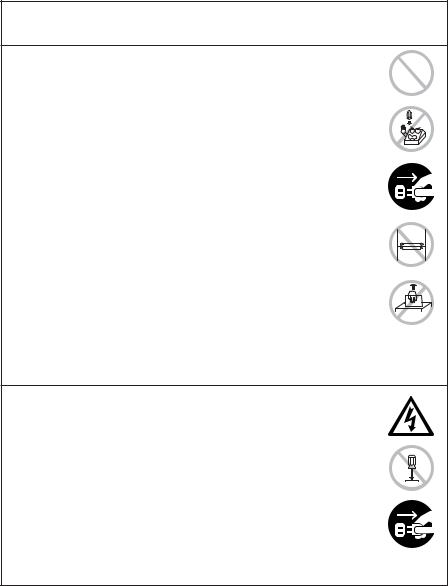
 CAUTION
CAUTION
To prevent possible malfunction or failure observe the following.
●Avoid operating the printer without paper properly loaded.
●Avoid the use of paper not complying with specifications.
•Otherwise thermal print head may be damaged and may result in poor print quality.
●Do not drop any metallic object such as paper clip, pin or screw into the printer.
●Do not spill coffee or any other liquid into the printer.
●Do not spray insecticide or any other chemical liquid over the printer.
• A metallic foreign object, if accidentally dropped into the printer, may cause printer failure, fire, or electric shock. Should it occur, immediately turn the printer off, unplug it from the supply outlet, and call your local CITIZEN SYSTEMS dealer.
●Avoid using torn pieces of paper or spliced with plastic adhesive tapes.
●Avoid forcibly pulling already loaded paper by hand.
•Otherwise paper jam may occur. If paper jam occurs, remove it correctly by referring to “Removing Jammed Paper” in this manual.
●Do not allow the printer to sustain strong impacts or hard jolts (e.g., trampling, dropping, striking with a hard edge).
To prevent injury and printer failures from worsening, observe the following:
●Do not touch the printing surface of the thermal head.
●Do not touch any of the moving parts (e.g., paper cutter, gears, active electrical parts) while the printer is working.
●In case of trouble do not attempt to repair the printer. Ask CITIZEN SYSTEMS service for repair.
●Be careful that the paper cover does not entrap your hands or fingers.
●Be careful with sharp edges on the printer. Don’t allow them to injure you or damage property.
•May result in electric shock, burn, or injury.
•If the printer emits smoke, an odd smell, or unusual noise while printing, immediately abort the current print session and unplug the printer from the supply outlet.
— 7 —
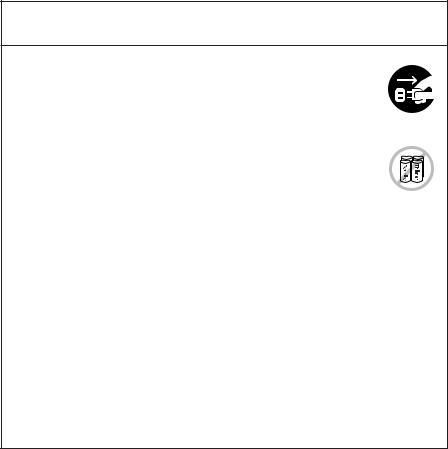
 DAILY MAINTENANCE
DAILY MAINTENANCE
Observe the following precautions for daily maintenance.
●When cleaning the printer, always turn it off and unplug it from the supply outlet.
●Use a soft, dry cloth for cleaning the surface of the printer case.
●For severe stains, use a soft cloth slightly dampened with water.
●Never use organic cleaning solvent such as alcohol, paint thinner, trichloroethylene, benzene, or ketone. Never use a chemically processed cleaning cloth.
●To remove paper chips, use a soft brush.
●When transporting the printer, remove the paper roll from its paper holder.
 CAUTION
CAUTION
•The thermal head is at a dangerously high temperature immediately after printing. Allow it to cool off before launching maintenance work.
●Clean the thermal head by wiping the dust off the surface of the heating element on the print head with gauze slightly moistened by alcohol.
 CAUTION
CAUTION
•Do not touch the heating element of the print head by bare hand or via metal strip.
•The thermal head is at a dangerously high temperature immediately
after printing. Allow it to cool off before launching maintenance work.
●Clean the presenter by wiping the dust off the surface of the rubber roller with gauze slightly moistened by alcohol.
— 8 —

THE TABLE OF CONTENTS
1. GENERAL OUTLINE.................................................................. |
12 |
||
1.1 |
Features ........................................................................................ |
12 |
|
1.2 |
Unpacking ..................................................................................... |
12 |
|
2. BASIC SPECIFICATIONS........................................................... |
13 |
||
2.1 |
Model Classification ..................................................................... |
13 |
|
2.1.1 |
PPU-700/PPU-700II Series .................................................................. |
13 |
|
2.1.2 |
Option .................................................................................................. |
14 |
|
2.2 |
Basic Specifications ..................................................................... |
15 |
|
2.3 |
Print Paper Specifications ........................................................... |
17 |
|
2.3.1 |
Specified Paper ................................................................................... |
17 |
|
2.3.2 |
Print Position ....................................................................................... |
18 |
|
2.3.3 Print Head and Paper Cut Position .................................................... |
19 |
||
2.3.4 Black Mark Layout and Operating Condition ................................... |
20 |
||
3. APPEARANCE AND COMPONENTS PARTS ........................... |
21 |
||
3.1 |
PPU-700/PPU-700II Printer ........................................................... |
21 |
|
3.2 |
Detector Position .......................................................................... |
23 |
|
3.3 |
PHU-3***(Paper Feed Unit) (Option) .......................................... |
24 |
|
4. OPERATION ............................................................................... |
25 |
||
4.1 |
Connecting AC Adapter and AC Cable ....................................... |
25 |
|
4.2 |
Connecting Interface Cables ....................................................... |
26 |
|
4.3 |
Interface Board Change ............................................................... |
27 |
|
4.4 |
Connecting PHU (Paper Feed Unit) ............................................ |
27 |
|
4.5 |
Connector for Operation Panel (CN500) ..................................... |
28 |
|
4.6 |
Setting/Replacing Paper Roll ....................................................... |
29 |
|
4.6.1 Paper Setting from Paper Side-in ...................................................... |
29 |
||
4.6.2 Paper Setting by Auto-loading .......................................................... |
30 |
||
4.6.3 When Using PHU-3 *** (Paper Feed Unit) ....................................... |
31 |
||
4.7 |
Removing the Remaining Paper Roll ......................................... |
32 |
|
4.8 |
Removing Jammed Paper ........................................................... |
32 |
|
4.9 |
Removing Cutter Lock ................................................................. |
33 |
|
4.10 Changing Paper Width ............................................................... |
34 |
||
4.11 FEED Switch ............................................................................... |
35 |
||
4.12 Paper End .................................................................................... |
35 |
||
4.13 Paper Near-End Sensor (When PHU-3*** is used) ................. |
36 |
||
4.14 Paper Retraction ......................................................................... |
37 |
||
4.15 |
Self-printing ................................................................................ |
37 |
|
4.16 Hexadecimal Dump Feature ...................................................... |
37 |
||
4.17 Operation Panel and Error Indication ....................................... |
38 |
||
— 9 —
5. NOTES ON EXTERIOR DESIGN ............................................... |
40 |
|
5.1 |
Notes on Paper Exit ..................................................................... |
40 |
5.2 |
Notes on Paper Collection Hole and Collection Path ................ |
42 |
5.3 |
Notes on Paper Insertion Path .................................................... |
43 |
5.4 |
PHU-3*** (Paper Feed Unit) Installation .................................... |
43 |
5.5 |
Layout Examples of Control Box ................................................ |
44 |
6. DIP SWITCHES .......................................................................... |
45 |
|
6.1 |
Setting DIP Switches .................................................................... |
45 |
6.2 |
DIP Switch Functions ................................................................... |
46 |
7. MEMORY SWITCHES ................................................................ |
47 |
|
7.1 |
Setting Memory Switches ........................................................... |
47 |
7.2 |
Memory Switch Functions .......................................................... |
49 |
APPENDIX-1. PPU-700 EXTERNAL VIEW .................................... |
52 |
|
APPENDIX-2. PPU-700II EXTERNAL VIEW ................................. |
53 |
|
APPENDIX-3. PPU-700 PHU-3*** (PAPER FEED UNIT) INSTALLATION.............. |
54 |
|
APPENDIX-4. BLOCK DIAGRAM .................................................. |
55 |
|
— 10 —

1. GENERAL OUTLINE
The PPU-700/PPU-700II are a printer designed for use with a broad array of terminal equipment including data, measuring instruments, outdoor information, or as a presenter for issuing various kinds of tickets and coupon tickets.
With extensive features, it can be used in a wide range of applications.
To obtain the best results from the PPU-700/PPU-700II printers, please read the instructions in this manual thoroughly.
1.1Features
(1)Paper side-insert mechanism facilitating paper insertion and maintenance.
(2)Paper width can be chosen among 58, 67, 80, and 82.5 mm.
(3)Line thermal printing allows high-speed, low-noise printing.
(4)Allows collection of paper not received. (Paper collection mechanism)
(5)Small size and light weight requiring minimum installation space.
(6)Long-life head and high reliability with simple mechanism.
(7)Built-in input buffer.
(8)Barcode printing is available with special command.
(9)Page mode allows free layout of printing.
(10)User-defined characters and logos can be registered in the flash memory.
(11)User-designed characters can be registered. (94 Kanji characters, 95 ANK characters)
(12)Detection of black mark is available. (Option)
(13)Free layout of each unit.
(14)Large-sized roll paper can be used. (Option)
(15)Built-in buzzer
(16)Various kinds of customization are available.
(17)2-color printing
(18)Equipped with USB interface as standard. (PPU-700II)
(19)Barcode & 2D Barcode printing is supported. (PPU-700II)
1.2Unpacking
After unpacking the printer, confirm that the following are provided.
●Printer: |
1 |
●User's Manual: |
1 |
 CAUTION!
CAUTION!
●Place the printer on the equipment positioned horizontally and stably.
●Avoid installation near heater or in direct sunlight.
●Avoid use in the environment with high temperature, high humidity, and very dirty.
●Avoid dew condensation. In the case of dew condensation, keep power off till dew condensation is cleared.
—12 —

2.BASIC SPECIFICATIONS
2.1Model Classification
The printer models are classified by the following designation method:
2.1.1 PPU-700/PPU-700II Series
PPU-700 - R U M1
PPU-700II - RS U M1
Model Name
Interface
In case of PPU-700
R: Serial (RS-232C)
P: Parallel (IEEE 1284 compliant)
U: USB
In case of PPU-700II
R: Serial (RS-232C) + USB
P: Parallel (IEEE 1284 compliant) + USB
U: USB
Character Set
U: International
J: Japan (Supporting Kanji code)
Black Mark Sensor Position (Option)
None: No Sensor (Standard)
M1: Rear Left
M2: Rear Right (Head Up Lever side)
M3: Left of Print Surface
— 13 —
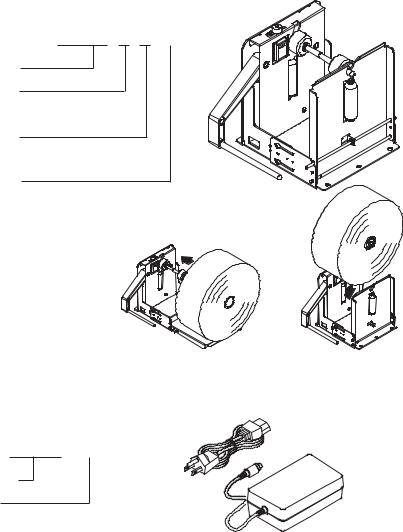
2.1.2 Option
(1) PHU Series (Paper Feed Unit)
PHU-3 3 1 S
Model Name
Shaft length
3: Paper width 58 to 82.5 mm (Standard) 2: Paper width 58 mm only
PNE Sensor
1:1 Sensor (Standard)
2:2 Sensors
Paper setting
S:Side (Standard)
T:Top
PHU-3**S |
PHU-3**T |
(2) 36AD2 Series (AC Adapter)
36AD2 - U
Model Name
AC Cable
U: USA (120V 3-core cord)
E: Europe (230V Class I Cord)
J: Japan (100V 3-core cord)
— 14 —

2.2 Basic Specifications
Model PPU-700-RU/PPU-700II-RSU
Item PPU-700-PU/PPU-700II-PAU
PPU-700-UU/PPU-700II-UBU
PPU-700-RK/PPU-700II-RSK PPU-700-PK/PPU-700II-PAK PPU-700-UK/PPU-700II-UBK
Print method |
Line thermal dot print method |
|
|
Print width |
80 mm/640 dots |
|
|
Dot density |
8 × 8 dots/mm (203 dpi) |
|
|
Print speed |
150 mm/sec (max., Print density level 2), (1200 dot lines/sec) |
||
Number of print |
Font A: 48 columns, 12 × 24 dots |
||
columns |
Font B: 64 columns, 9 × 17 dots |
|
|
|
Font C: 72 columns, 8 × 16 dots |
|
|
|
|
|
Kanji Font A: 24 columns, 24 × 24 dots |
|
|
|
Kanji Font B: 36 columns, 16 × 16 dots |
Character size |
Font A: 1.50 × 3.00 mm |
|
|
|
Font B: 1.13 × 2.13 mm |
|
|
|
Font C: 1.00 × 2.00 mm |
|
|
|
|
|
Kanji Font A: 3.00 × 3.00 mm |
|
|
|
Kanji Font C: 2.00 × 2.00 mm |
Character type |
Alphanumeric characters, International characters, PC850, 852, 857, 858, |
||
|
860, 863, 865, 866, WPC1252, Katakana |
||
|
|
|
Kanji (JIS Level 1, Level 2) |
User memory |
256 KB (Capable of registering user-defined characters and logos) |
||
Barcode type |
UPC-A/E, JAN (EAN) 13 colummns/8 columns, ITF, CODE 39, CODE 128, |
||
|
CODABAR, CODE 93, QR Code (PPU-700II Only), PDF417 (PPU-700II Only) |
||
Line spacing |
4.23 mm (1/6 in.), selectable by use of command |
||
Paper |
Thermal paper roll |
|
|
(See paper spec.) |
|
Width: 58 to 82.5 mm |
|
|
|
External diameter: φ203 mm max. (when using PHU) |
|
|
|
Core: Internal diameter: φ25.4 mm, Outer diameter: φ30 mm or more |
|
|
|
Paper thickness: 65 to 150 µm |
|
Presenter |
Standard length: 90 mm |
|
|
Interface *1 |
Serial (RS-232C compliant), Parallel (IEEE1284 compliant), USB Interface |
||
Input buffer |
4K bytes/72 bytes |
|
|
Supply voltage |
DC 24V ±7% |
|
|
Power consumption |
100 W |
|
|
AC adapter |
Rated input: AC 100V to 240V, 50/60 Hz, 150 VA |
||
specification |
Rated output: DC 24V, 2A |
|
|
Type |
36AD2-U |
36AD2-E |
36AD2-J |
Weight |
2.1 kg |
|
|
Outside dimensions |
163.2 (W) × 176 (D) × 144 (H) mm (See external view) |
||
Operating temperature |
5 to 40°C (PPU-700), –10 to 50°C (PPU-700II), |
||
and humidity |
35 to 85% RH (No dew condensation) |
||
Storage temperature |
–20 to 60°C, 10 to 90% RH (No dew condensation) |
||
and humidity |
|
|
|
— 15 —
